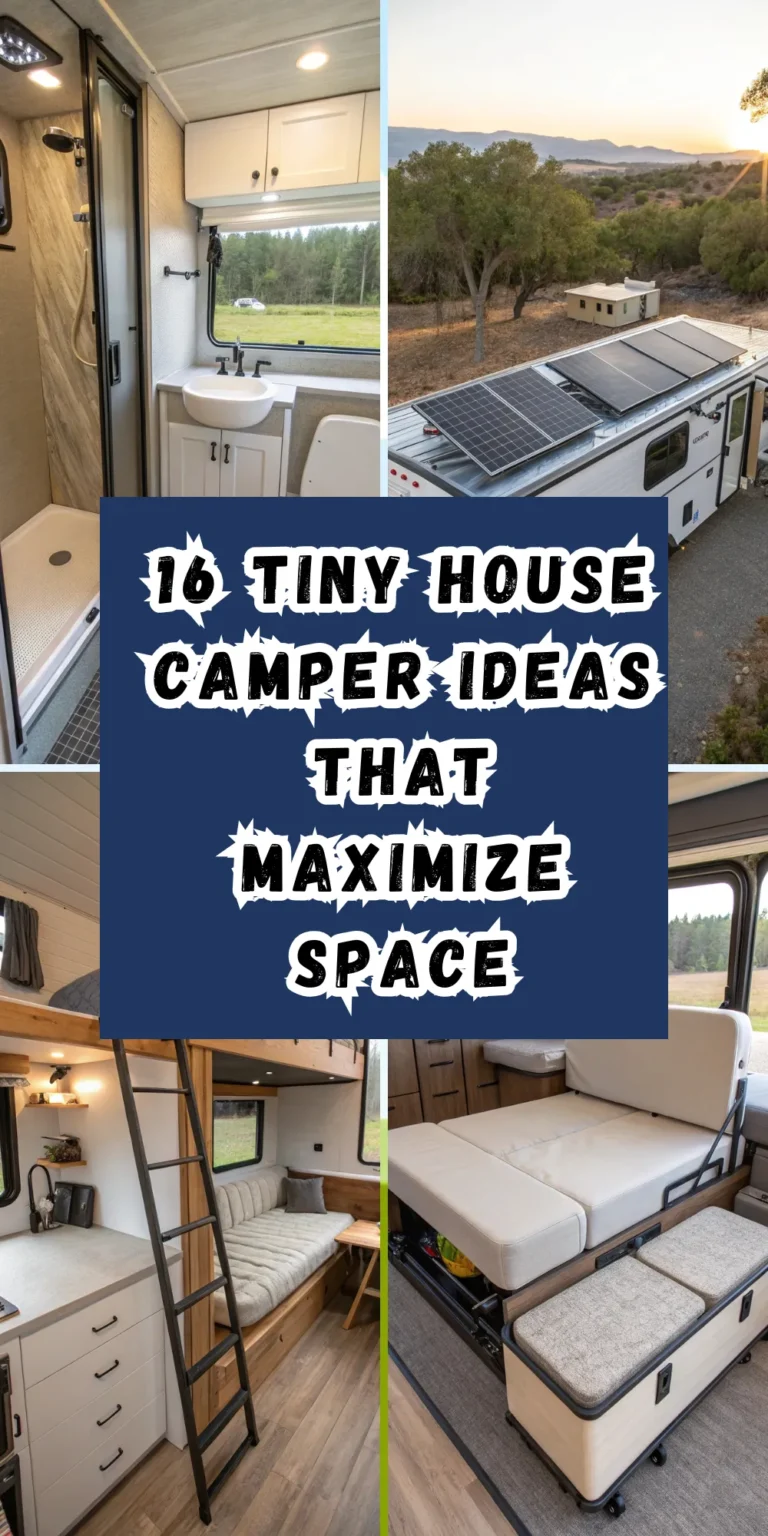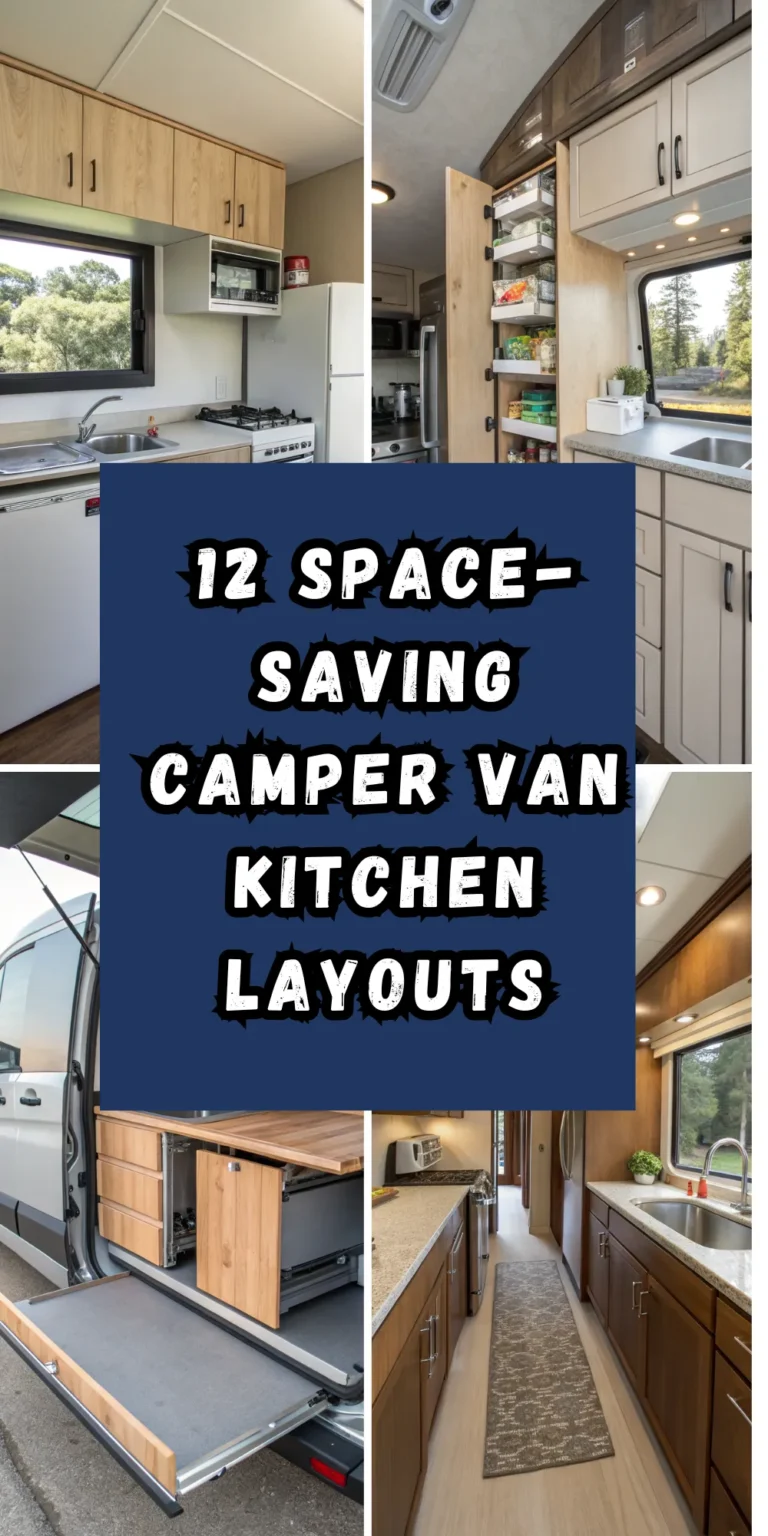13 Small Camper Interior Ideas for a Cozy Road Life
Small campers offer the perfect blend of mobility and comfort, but making the most of limited square footage requires creativity and smart design choices. The challenge isn’t just fitting everything you need—it’s creating a space that feels like home rather than just a place to sleep.
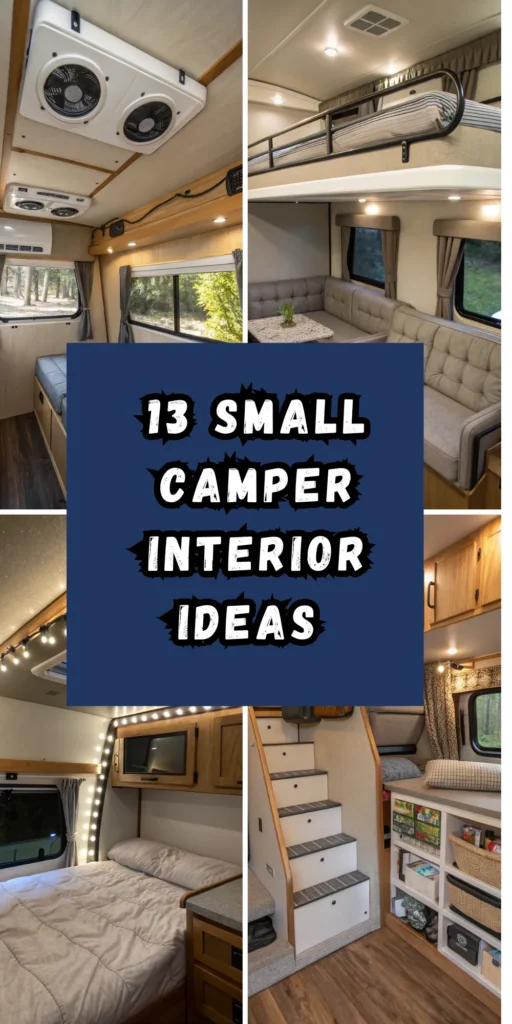
The secret to successful small camper living lies in maximizing every inch while maintaining a sense of openness and comfort. From clever storage solutions to multi-functional furniture, the right interior design can transform even the tiniest travel trailer or van into a cozy, functional home on wheels.
Whether you’re renovating a vintage Airstream, converting a cargo trailer, or optimizing a factory-built small camper, these interior ideas will help you create a space that supports your adventurous lifestyle without sacrificing comfort or style.
In this article, we’ll explore 13 brilliant small camper interior ideas that prove big dreams can fit in small spaces.
Murphy Bed with Integrated Storage
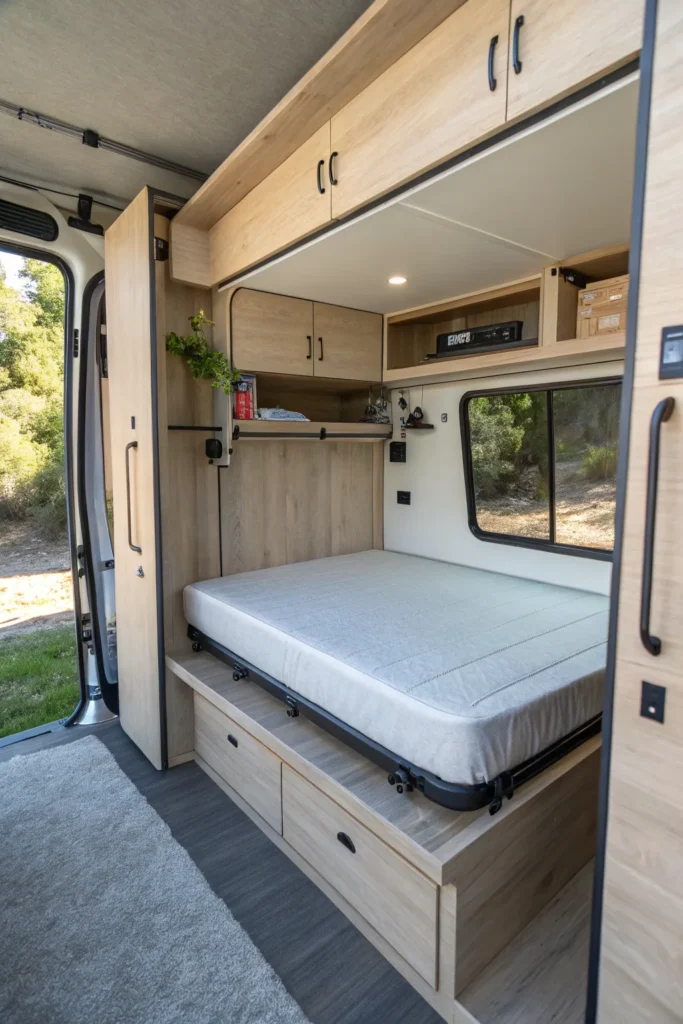
Why try this? A fold-down bed transforms your living space during the day while providing essential storage behind it.
Implementation: Install a wall-mounted bed frame with gas struts for easy lifting. Build storage shelves, cabinets, or even a small desk into the wall space behind the bed. Use lightweight materials to reduce strain on mounting hardware.
Who benefits: Solo travelers or couples who want maximum daytime living space without giving up a comfortable sleeping area.
Pro tip: Add soft-close mechanisms and safety latches to prevent accidental folding—safety should always come first in small spaces.
Convertible Dinette to Bed Design
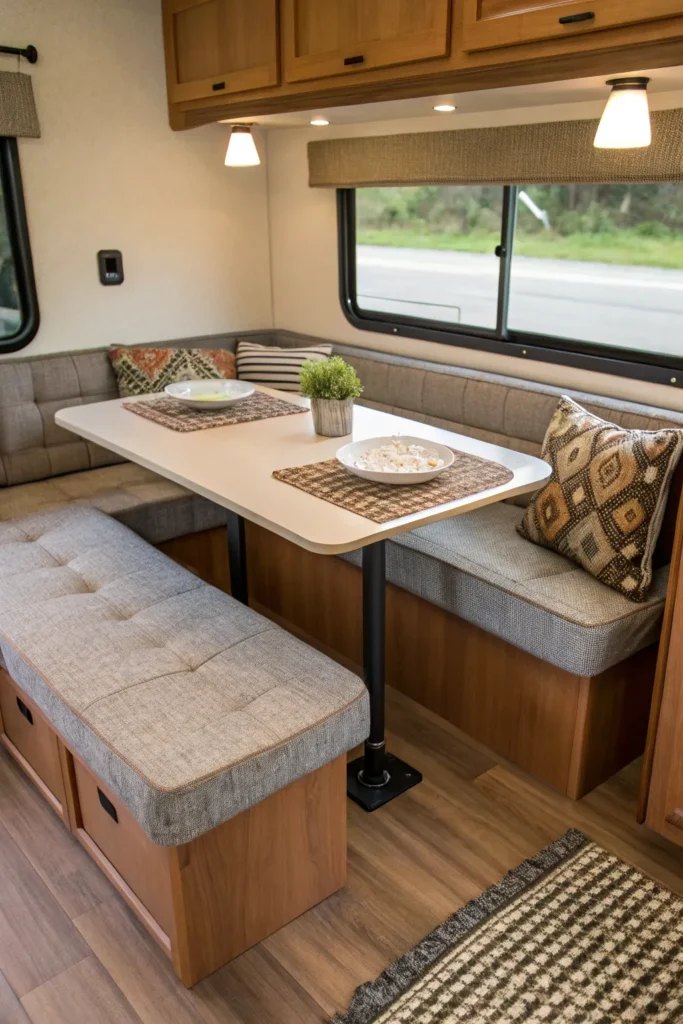
Transform your dining area into sleeping space with smart convertible furniture.
Implementation: Install a dinette table that lowers to bed height or removes completely. Design bench cushions that rearrange to create a mattress platform. Use storage underneath benches for bedding and personal items.
Best for: Small families or those who prioritize social dining space but need flexible sleeping arrangements.
Con: Requires nightly conversion and storage of bedding—consider whether this routine fits your travel style.
Floor-to-Ceiling Storage Solutions
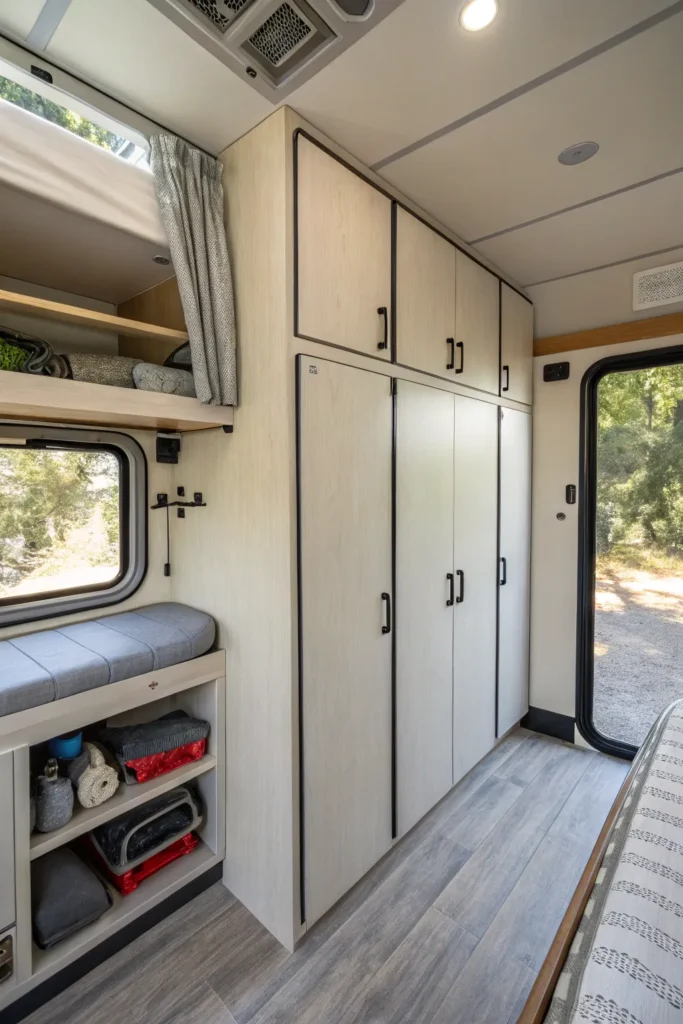
Maximize vertical space with tall storage that reaches every available inch.
How to: Install floor-to-ceiling cabinets along one or more walls. Use upper cabinets for lightweight, less-frequently used items. Include both open shelving for easy access and closed cabinets for clutter-free appearance.
Why it works: Dramatically increases storage capacity while keeping floor space open for living activities.
Pro tip: Install cabinet locks or bungee cords to prevent doors from opening during travel and items from shifting.
Multi-Level Living with Loft Spaces
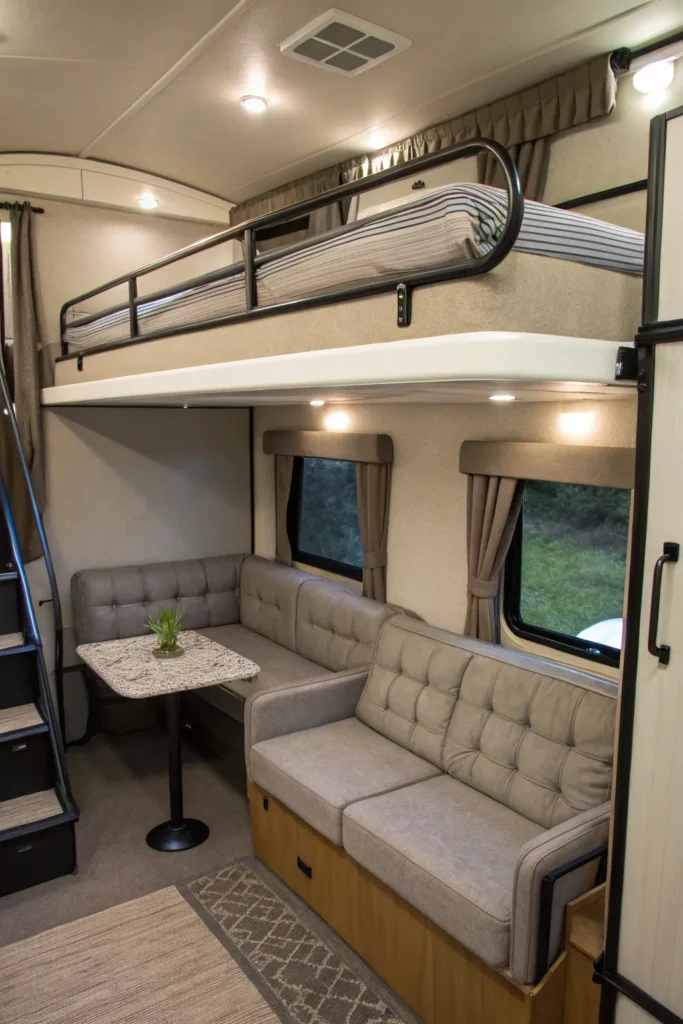
Why try this? Raised sleeping areas free up valuable floor space for other essential functions.
Steps: Build a loft platform for sleeping with living space underneath. Ensure adequate headroom in both areas—typically 3.5 feet minimum under loft, 4+ feet in loft sleeping area. Use space under loft for seating, storage, or workspace.
Who benefits: Those comfortable with climbing into bed and wanting to maximize small camper footprint.
Downside: Not suitable for everyone due to mobility limitations—consider your physical needs carefully.
Slide-Out Storage Drawers and Trays
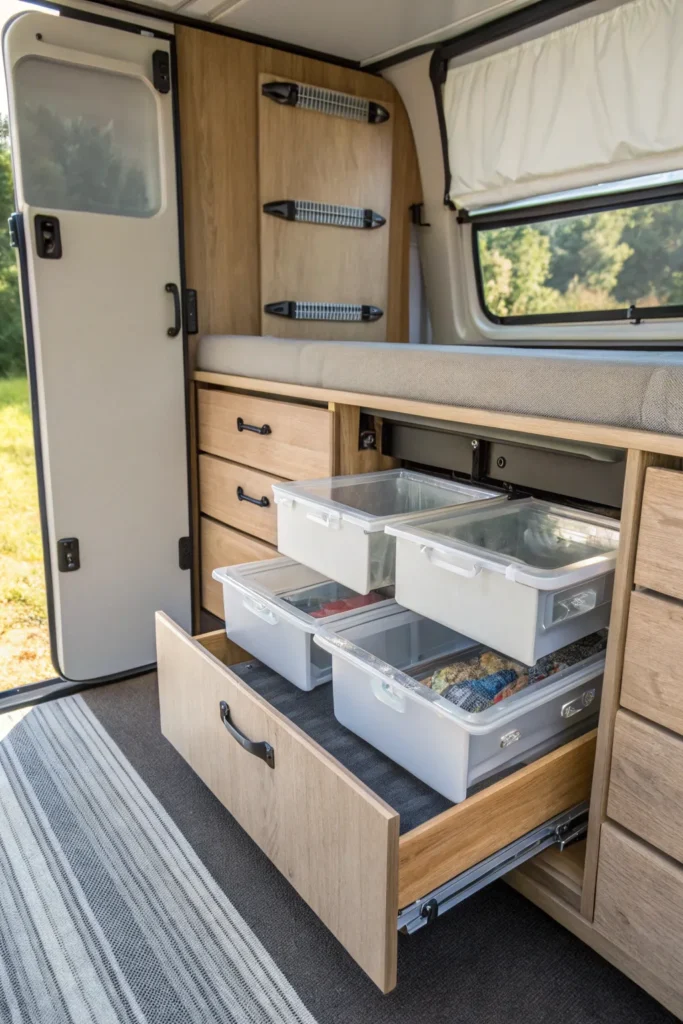
Hidden storage that glides out provides easy access to deep cabinet contents.
Implementation: Install heavy-duty drawer slides in cabinets and under-bed spaces. Create custom-sized drawers and trays that maximize available space. Use clear containers or open trays for easy identification of contents.
Why it matters: Prevents items from getting lost in deep storage while maximizing use of every available cubic inch.
Con: Quality drawer slides are expensive—but they’re essential for reliable function during travel.
Compact Wet Bath with Smart Layout
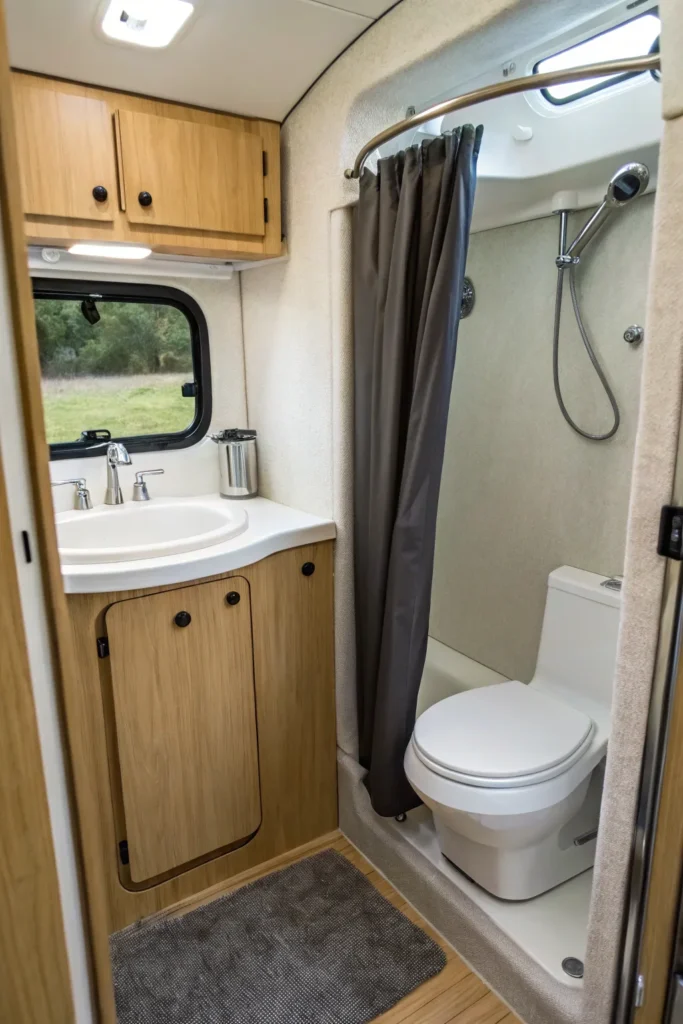
Budget-friendly option that includes toilet and shower in minimal space.
How to: Design a wet bath where shower, toilet, and sink share the same small space. Use a fold-down sink, wall-mounted toilet, and efficient drainage. Install a curved shower curtain or glass partition for water control.
Why it works: Provides complete bathroom functionality in spaces as small as 3×3 feet.
Pro tip: Use marine-grade fixtures and ventilation to prevent moisture problems in small spaces.
Outdoor Living Extensions and Awnings

Expand your living space beyond the camper walls with outdoor rooms.
How to: Install a high-quality awning with sidewalls to create protected outdoor living space. Add outdoor furniture, rugs, and lighting to extend your comfort zone. Consider slide-out outdoor kitchens or storage.
Best for: Fair-weather travelers who want to significantly expand their living space when parked.
Drawback: Weather-dependent and requires setup time—not practical for frequent movers or harsh climates.
Built-In Workspace and Office Area
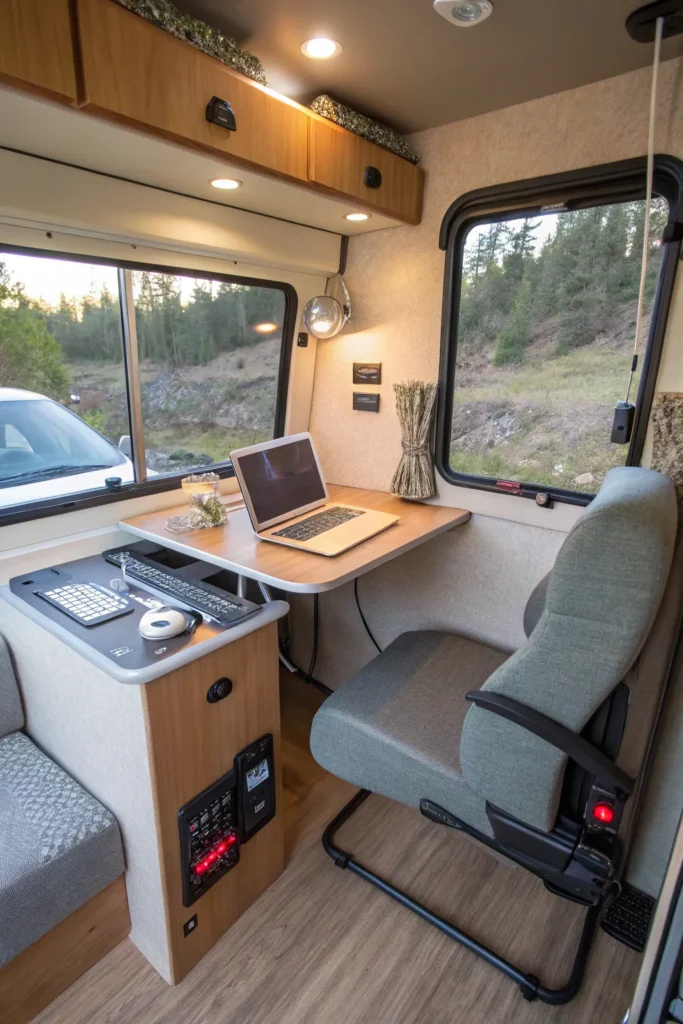
Dedicated work areas support remote work and digital nomad lifestyles.
Steps: Design a compact desk that folds down from a wall or converts from other furniture. Include adequate electrical outlets, lighting, and ergonomic seating. Ensure stable internet connectivity options.
Why it’s helpful: Maintains productivity while living on the road without sacrificing other essential living functions.
Pro tip: Choose a desk height that works for both laptop use and dining to maximize multi-functional capability.
Creative Lighting for Ambiance and Function
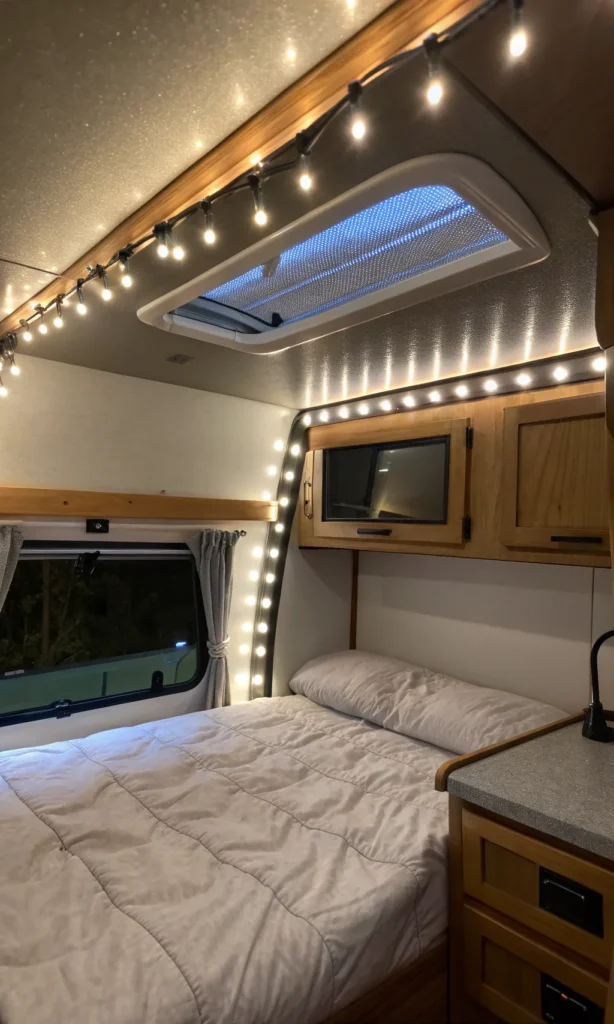
Strategic lighting makes small spaces feel larger and more comfortable.
How-to: Layer different types of lighting including LED strips, reading lights, and ambient fixtures. Use warm white LEDs for relaxation and bright white for tasks. Install dimmer switches for mood control.
Best for: Anyone wanting to create a homey atmosphere and avoid the harsh, cramped feeling common in small spaces.
Con: Multiple light fixtures require careful electrical planning—consider your power consumption and generation capacity.
Flexible Seating and Lounge Areas
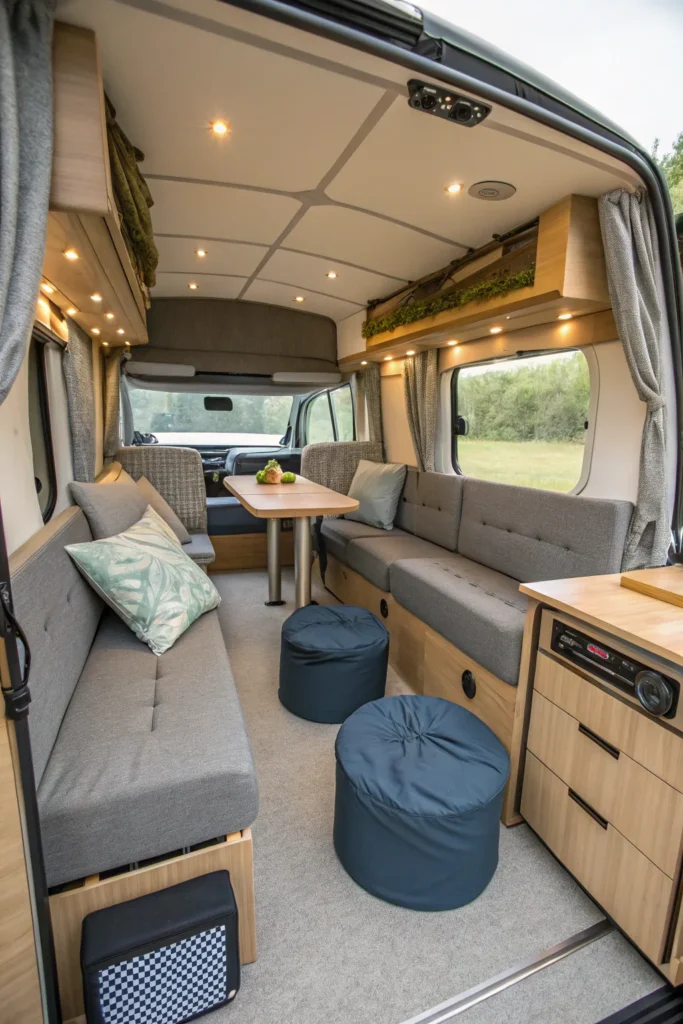
Modular seating adapts to different activities and group sizes.
Implementation: Choose lightweight, moveable seating that can be rearranged for socializing, relaxing, or working. Consider inflatable furniture, folding chairs, or modular cushions that store compactly.
Who benefits: Social travelers who entertain guests or need flexible space for different activities throughout the day.
Styling tip: Choose seating with built-in storage to maximize functionality while maintaining comfort.
Smart Climate Control Solutions
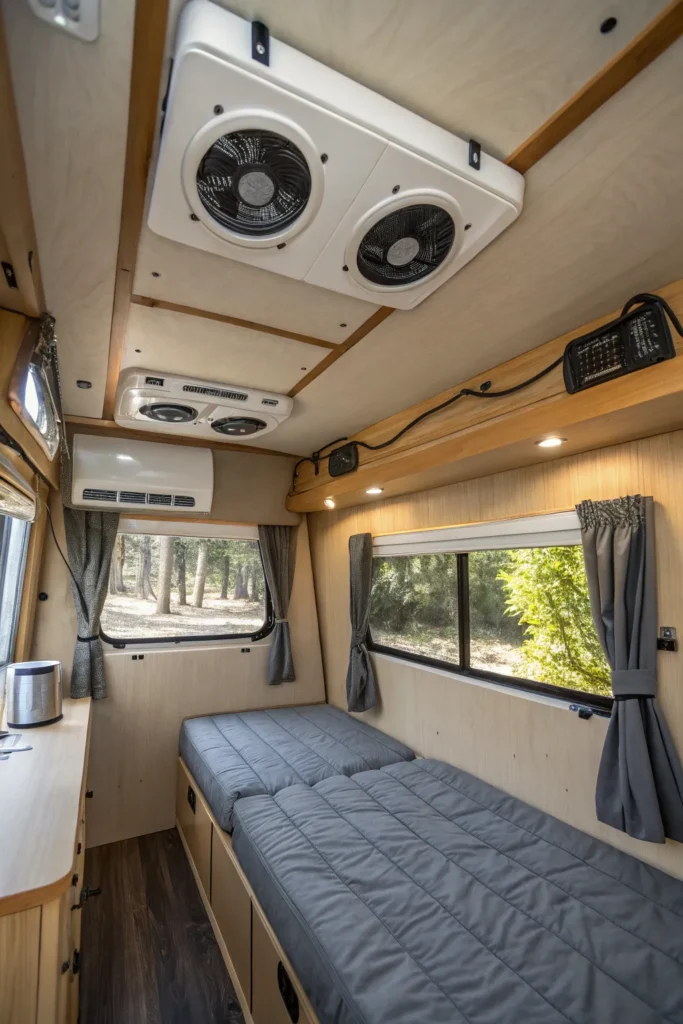
Efficient heating and cooling systems maintain comfort in small spaces.
Steps: Install properly sized ventilation fans, efficient heating systems, and consider portable AC units. Use thermal window coverings and insulation to maintain comfortable temperatures with minimal energy use.
Best for: Four-season travelers who need reliable climate control in extreme weather conditions.
Pro tip: Focus on insulation and ventilation first—they’re often more cost-effective than increasing heating or cooling capacity.
Hidden Storage in Unexpected Places
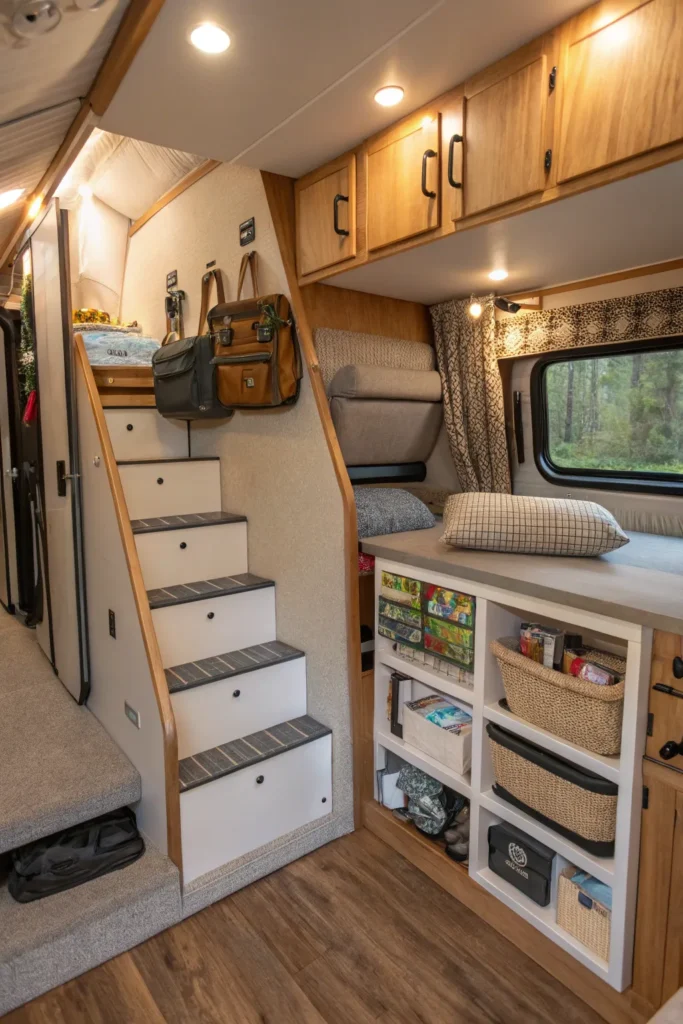
Maximize storage by utilizing every possible space throughout the camper.
How-to: Add storage under stairs, inside hollow furniture, behind wall panels, and in ceiling areas. Use magnetic strips, hooks, and organizers on every available surface. Create hidden compartments in floors or walls.
Why it works: Dramatically increases storage capacity without adding bulk or reducing living space.
Drawback: Can make cleaning more complex—organize thoughtfully to maintain accessibility.
Personalized Decor and Comfort Features
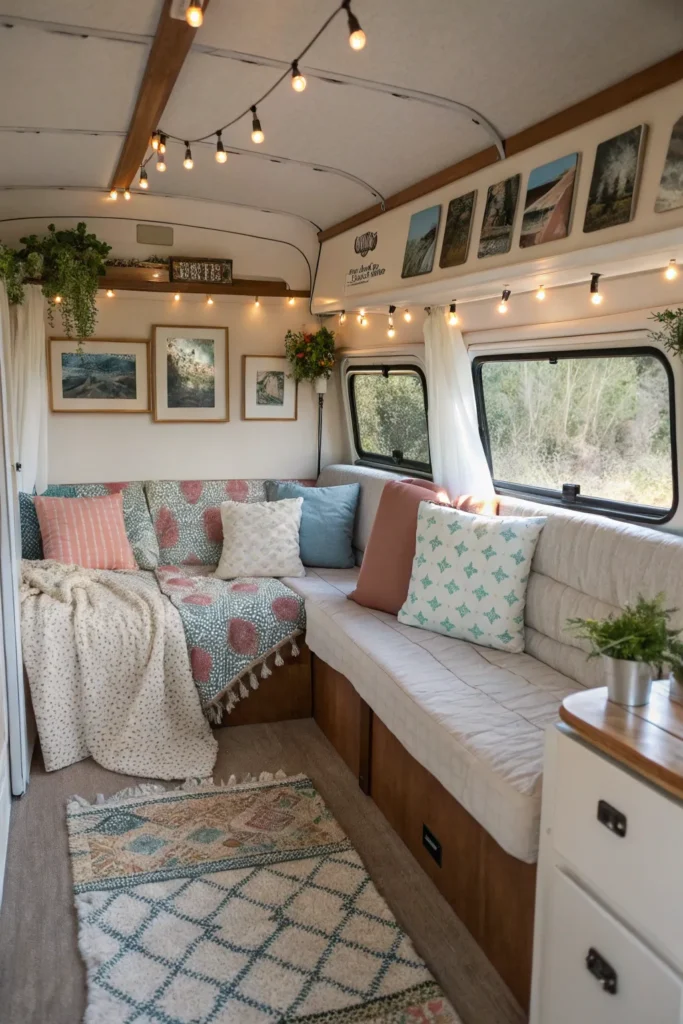
Make your small space feel like home with personal touches and comfort upgrades.
Implementation: Add soft furnishings, artwork, plants, and personal mementos that reflect your style. Choose lightweight, travel-friendly decor that can be secured during travel. Focus on textures and colors that make the space feel warm and inviting.
Who benefits: Anyone wanting their camper to feel like home rather than just temporary shelter.
Con: Personal items take up valuable space—choose meaningful pieces that truly enhance your daily experience.
Creating Your Perfect Small Camper Interior
These 13 small camper interior ideas prove that limitations in square footage don’t have to mean limitations in comfort, functionality, or style. The key is thoughtful planning, quality components, and creative solutions that serve multiple purposes while reflecting your personal travel style.
Consider your actual living patterns, travel frequency, and must-have amenities when designing your small camper interior. Don’t try to replicate a full-sized home—instead, focus on the essentials that make your adventures more comfortable and enjoyable. Remember that the best small camper interior is one that supports your travel dreams while feeling like home wherever you park.
With careful planning and smart design choices, your small camper can provide years of comfortable adventures, proving that some of life’s best experiences come in the smallest packages.

